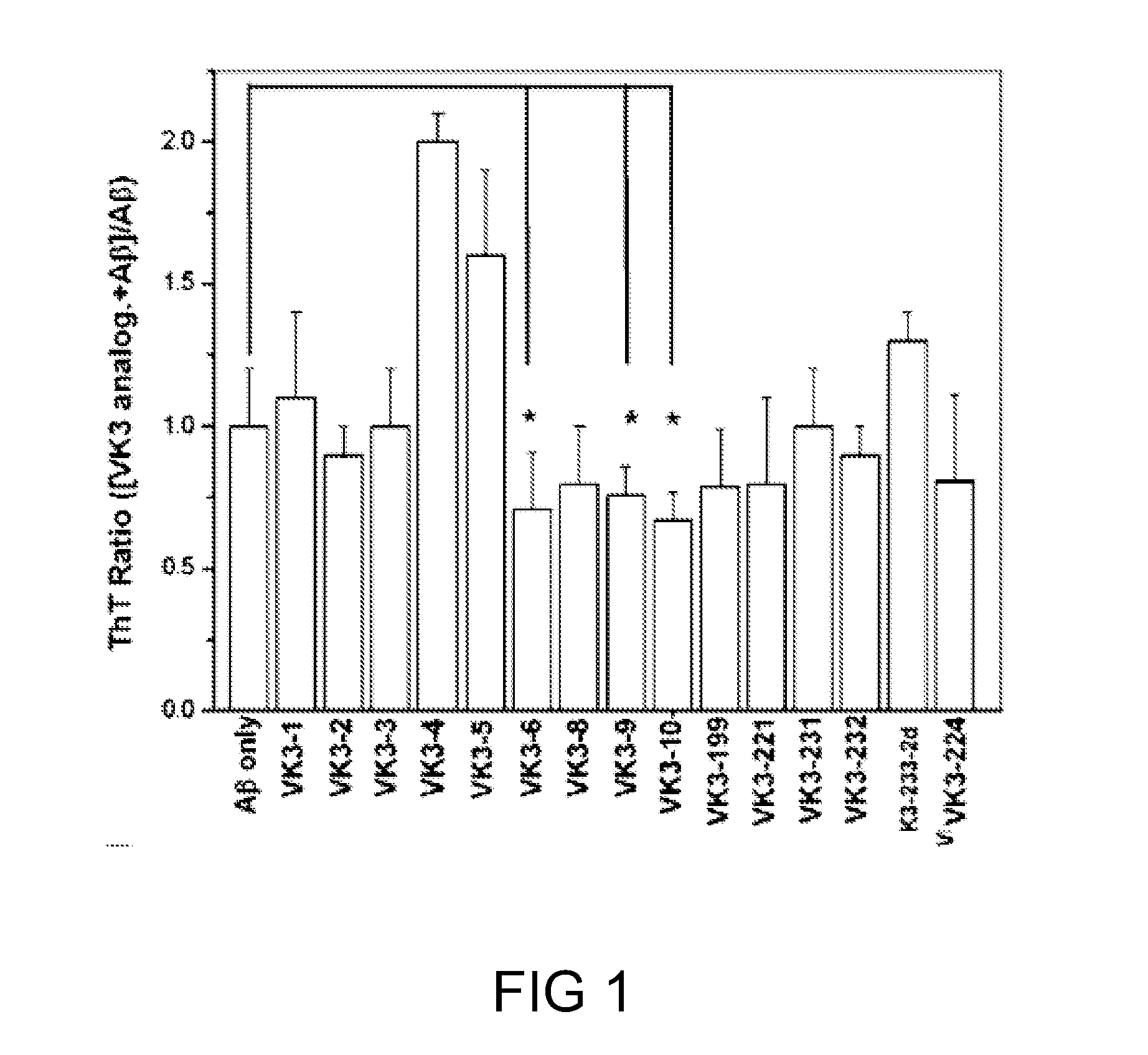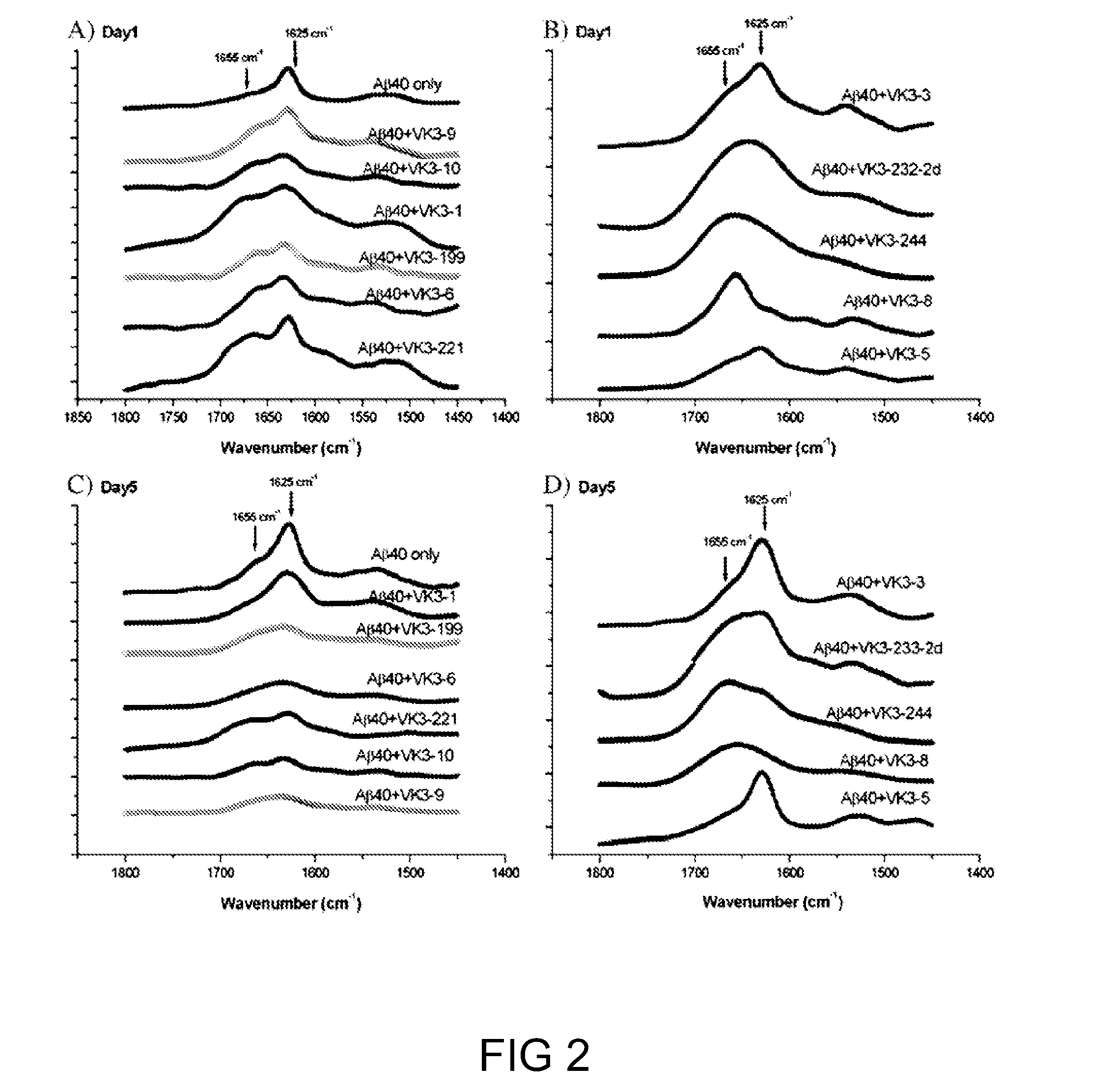Methods for treating neurodegenerative diseases associated with aggregation of amyloid-beta
a technology of amyloidbeta and neurodegenerative diseases, applied in the field of menadione derivatives, can solve the problem of no cure or treatment for such diseases
- Summary
- Abstract
- Description
- Claims
- Application Information
AI Technical Summary
Benefits of technology
Problems solved by technology
Method used
Image
Examples
example 1
The Compound of Formula (I) Inhibits the Aggregation of Aβ1-40
[0065]In this example, the effects of the compound of formula (I) on the aggregation of Aβ1-40 were investigated using the Th-T fluorescence assay described above in the Material and Methods section. Results are depicted in FIG. 1.
[0066]As evident from FIG. 1, several compounds of formula (I) of the present disclosure, including VK3-2, VK3-6, VK3-8, VK3-9, VK3-10, VK3-199, VK3-221, and VK3-224 compounds, were all capable of preventing Aβ1-40 from aggregation. Among them, VK3-6, VK3-9, and VK3-10 were most potent. By contrast, some compounds of formula (I) of the present disclosure, including VK3-1, VK3-4, VK3-5 and VK3-233-2d, were capable of enhancing the aggregation of Aβ1-40.
example 2
Effects of Compound of Formula (I) on the Secondary Structure of Aβ1-40
[0067]It is known that during the aggregation process, the conformation of Aβ1-40 is converted to either helix or random coil β-sheet. Hence, in this example, the effects of compounds of formula (I) on the conformation of Aβ1-40 were investigated. Results are depicted in FIG. 2.
[0068]The conformation of Aβ1-40 in the presence of VK3-2, VK3-6, VK3-8, VK3-9, VK3-10, VK3-199, VK3-221, and VK3-224 compounds remained mostly in random coil conformation on both days 1 and 5, as the 1650 cm−1 major peak was an indication of random coil. By contrast, the 1650 cm−1 peak that appeared in the FT-IR spectra of Aβ1-40 alone or in the presence of VK3-1, VK3-3, VK3-5, and VK3-232-2d on day 1 shifted to 1625 cm−1 on day 5, which indicated that Aβ1-40 had converted to β-sheet structure. The results are consistent with the finding in Example 1, in which VK3-6, VK3-9, VK3-10, VK3-199, and VK3-221 compounds inhibited the conformation...
example 3
Effects of Compound of Formula (I) on Aβ1-40 Induced Cell Death
[0069]In this example, the effects of compounds of formula (I) on Aβ1-40 induced cell toxicity were investigated by cell viability assay. Results are depicted in FIG. 3.
[0070]Unlike the findings from aggregation and secondary structure studies as described above in FIGS. 1 and 2, cell viability assay as illustrated in FIG. 3 indicated that only compound VK3-9 exhibited the ability of preventing Aβ1-40 induced cell death at concentration below 100 ng / mL, whereas the rest of compound of formula (I) including VK3-1, VK3-2, VK3-3, VK3-4, VK3-5, VK3-6, VK3-8, VK3-10, VK3-119, VK3-221 and VK3-231, had smaller effects. As to compounds VK3-232, VK3-233-2d, and VK3-224, their effects as measured by cell viability assay showed no difference from that of the control (i.e., 25 μM Aβ1-40 alone). Further studies indicated that compound VK3-9 suppressed Aβ1-40 induced cell death in a dose-dependent manner, cell survival rate increased ...
PUM
| Property | Measurement | Unit |
|---|---|---|
| body weight | aaaaa | aaaaa |
| body weight | aaaaa | aaaaa |
| body weight | aaaaa | aaaaa |
Abstract
Description
Claims
Application Information
 Login to View More
Login to View More - R&D
- Intellectual Property
- Life Sciences
- Materials
- Tech Scout
- Unparalleled Data Quality
- Higher Quality Content
- 60% Fewer Hallucinations
Browse by: Latest US Patents, China's latest patents, Technical Efficacy Thesaurus, Application Domain, Technology Topic, Popular Technical Reports.
© 2025 PatSnap. All rights reserved.Legal|Privacy policy|Modern Slavery Act Transparency Statement|Sitemap|About US| Contact US: help@patsnap.com



